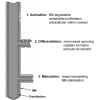Tumour angiogenesis: the relevance to surgeons
- PMID: 17059709
- PMCID: PMC1963738
- DOI: 10.1308/003588406X117106
Tumour angiogenesis: the relevance to surgeons
Abstract
Introduction: Angiogenesis is the process of new blood vessel formation from pre-existing vessels, and is a key feature of malignant tumours. Surgeons involved in the management of patients with malignant disease need to be aware of angiogenic mechanisms and their surgical implications.
Patients and methods: A literature search was used to review recent developments in our understanding of the factors and processes involved in tumour angiogenesis, and how these will impact on the care of patients with malignant disease encountered by surgeons.
Results: Angiogenesis is fundamental to all stages of the malignant process, and involves a complex interaction between mediators secreted by tumour cells and host cells. Intense investigation continues into therapies targeting components of the angiogenic cascade. Imaging modalities capable of measuring the angiogenic activity of a tumour are also being studied in order to predict prognosis and select suitable patients for anti-angiogenic therapy.
Conclusions: As the use of these anti-angiogenic therapies becomes more wide-spread, they may have implications on the healing rates of cutaneous wounds and intracorporeal anastomoses.
Figures



Similar articles
-
The role of angiogenesis in solid tumours: an overview.Eur J Intern Med. 2009 Nov;20(7):663-71. doi: 10.1016/j.ejim.2009.07.009. Epub 2009 Aug 27. Eur J Intern Med. 2009. PMID: 19818284 Review.
-
Tumour angiogenesis: its mechanism and therapeutic implications in malignant gliomas.J Clin Neurosci. 2009 Sep;16(9):1119-30. doi: 10.1016/j.jocn.2009.02.009. Epub 2009 Jun 24. J Clin Neurosci. 2009. PMID: 19556134 Review.
-
[Tumour angiogenesis and therapy directed at the neovasculature].Tidsskr Nor Laegeforen. 2004 Aug 12;124(15):1919-22. Tidsskr Nor Laegeforen. 2004. PMID: 15306859 Review. Norwegian.
-
Novel anti-angiogenic therapies for malignant gliomas.Lancet Neurol. 2008 Dec;7(12):1152-60. doi: 10.1016/S1474-4422(08)70260-6. Lancet Neurol. 2008. PMID: 19007739 Review.
-
Molecular diagnosis of tumor angiogenesis and anti-angiogenic cancer therapy.Int J Clin Oncol. 2003 Aug;8(4):200-6. doi: 10.1007/s10147-003-0342-8. Int J Clin Oncol. 2003. PMID: 12955574 Review.
Cited by
-
The "cavitary" type of angiogenesis by gastric cancer. Morphological characteristics and prognostic value.J Cancer. 2014 Mar 20;5(5):311-9. doi: 10.7150/jca.8716. eCollection 2014. J Cancer. 2014. PMID: 24723973 Free PMC article.
-
Prognostic value of circulatory growth factors to predict responsiveness to chemotherapy and remission status of patients with acute myeloid leukemia.Arch Med Sci. 2024 May 29;20(6):1887-1893. doi: 10.5114/aoms/185617. eCollection 2024. Arch Med Sci. 2024. PMID: 39967929 Free PMC article.
-
Difficulties in the management of mesenchymal hamartomas.Pediatr Surg Int. 2008 Oct;24(10):1171-5. doi: 10.1007/s00383-008-2239-0. Epub 2008 Aug 28. Pediatr Surg Int. 2008. PMID: 18751987
-
Methylation-based immune deconvolution in prostate cancer patients before and after radical prostatectomy.Cancer Causes Control. 2025 Feb;36(2):101-106. doi: 10.1007/s10552-024-01924-x. Epub 2024 Oct 10. Cancer Causes Control. 2025. PMID: 39390262
-
Impact of breast cancer surgery on angiogenesis circulating biomarkers: a prospective longitudinal study.World J Surg Oncol. 2013 Aug 27;11:213. doi: 10.1186/1477-7819-11-213. World J Surg Oncol. 2013. PMID: 23981902 Free PMC article.
References
-
- Noden DM. Embryonic origins and assembly of blood vessels. Am Rev Respir Dis. 1989;140:1097–103. - PubMed
-
- Ellis LM, Liu W, Ahmad SA, Fan F, Jung YD, Shaheen RM, et al. Overview of angiogenesis: biologic implications for antiangiogenic therapy. Semin Oncol. 2001;28(Suppl 16):94–104. - PubMed
-
- Li WW. Tumor angiogenesis: molecular pathology, therapeutic targeting, and imaging. Acad Radiol. 2000;7:800–11. - PubMed
-
- McNamara DA, Harmey JH, Walsh TN, Redmond HP, Bouchier-Hayes DJ. Significance of angiogenesis in cancer therapy. Br J Surg. 1998;85:1044–55. - PubMed
-
- Tischer E, Mitchell R, Hartman T, Silva M, Gospodarowicz D, Fiddes JC, et al. The human gene for vascular endothelial growth factor. Multiple protein forms are encoded through alternative exon splicing. J Biol Chem. 1991;266:11947–54. - PubMed
Publication types
MeSH terms
Substances
LinkOut - more resources
Full Text Sources
Medical
Research Materials

